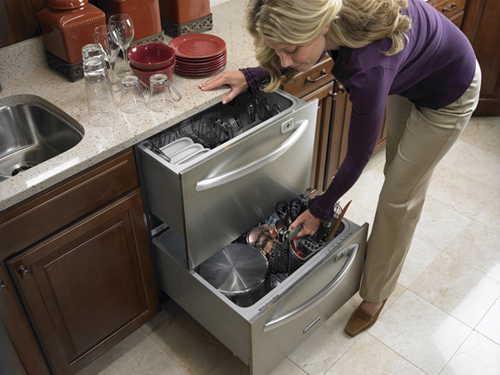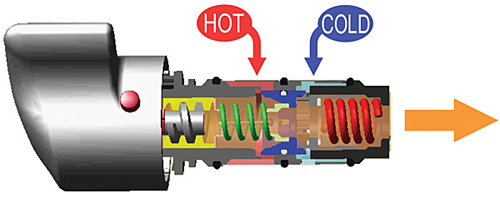Innovations in Smart, Universal, Energy-efficient and Water-saving Home Appliances
Dishwashers
Like refrigerators, older dishwashers are energy hogs and they can waste as much as 8 gallons of water per cycle. Dual-drawer dishwashers allow the homeowner to use even less energy and water by providing the option to run only one of the units in a cycle. Quieter models are available to help with energy savings as well as acoustic control if the machine cannot be insulated or installed adjacent to an insulated wall in the home. Some dishwashers are also equipped with delay wash, which can be used with Smart Grid technology, to shift energy consumption to off-peak utility hours. New energy-saving features on dishwashers include:
- Soil sensors that will reduce the necessity of re-washing dishes that are not cleaned properly.
- Cycle selectors that automatically select the optimum settings for each load of dishes.
- Sanitary rinse cycles, certified by the National Sanitation Foundation (NSF) to eliminate 99 percent of all food soil bacteria
- No heat-drying
 |
The homeowner may choose to operate the dish drawers independently of one another. Photo: KitchenAid® |
Â
Laundry - the new hobby center
Washing machine manufacturers as well as detergent manufacturers are beginning to use a new blue label with the letters HE. To use the HE label, the appliances must meet strict industry guidelines and use less water, less energy and less detergent. HE or high efficient washing machines use approximately 40 percent less water than traditional washing machines and 50 percent less energy. Consumers will also need to purchase HE detergent for these machines, a product which is now readily available at little or no additional cost. HE washing machines are usually front-loading, although there are some top-loading models on the market. HE machines are designed to saturate clothing and spin them at very high speeds in order to extract more water. Sensors monitor water temperature and the rinse cycles use a repeated, high-pressure spray, rather than a soaking action. The agitation cycles are shorter, reducing the wear and tear on clothing. When paired with a dryer from the same company, the consumer can maximize the energy use by reduced drying time. When selecting a washing machine that is eligible for consumer rebates, the design professional must make sure that it is not only ENERGY STAR labeled, but also has the appropriate tier of water conservation. Many states require a high, water-saving certification rating in order to receive the rebates. For example, the Michigan Energy Efficient Appliance Rebate Program, supplies a list of products approved by the Consortium for Energy Efficiency (CEE).10
CEE is a consortium of efficiency program administrators from across the U.S. and Canada who work together on common approaches to advancing efficiency.11 The washers on this list have a modified energy factor that is close to or above 2 and a water factor that is above 3; both measurements of higher saving and efficiency. Manufacturers submit their models to CEE for rating as determined by test procedures set by the U.S. Department of Energy.
Many of these machines are designed to be seen, not hidden in the basement, and many design professionals are finding a niche for homeowners who want their laundry center to also include a crafts, gardening, or hobby center.
Universal Design - Bathrooms and Kitchens
Legislation requiring accessibility mandated a number of changes in how architects design. However, The Americans with Disabilities Act (ADA) has been primarily interpreted as the removal of barriers mainly for those with limited mobility, focusing most standards on wheelchair access. Universal design is a global movement based on best practices for all ages and abilities. Universal designers address social and ergonomic needs of all humans. The Institute for Human-Centered Design and Adaptive Environments, describes Universal Design as:
" …a framework for the design of places, things, information, communication and policy that focuses on the user, on the widest range of people operating in the widest range of situations without special or separate design… or Human Centered design (of everything) with everyone in mind."12
According to this Institute, design must be equitable for all and include human functioning principles that are ergonomic, multi-sensory, cognitively sound and creates designs that are flexible, tolerant of error, efficient, predictable and stable. According to the United Nations Secretariat, the segment of world population, aged sixty years or older, is expected to double by 2025. In this time period, those with disabilities are estimated at 650 million persons worldwide, and of those, 80 percent will be in developing countries. Today, the most common reasons for limited mobility in American adults are arthritis, back problems, obesity, heart and respiratory disease. Sensory limitations in the U.S. also include sight and hearing loss, only some related to aging. These are just some of the statistics gathered by the Institute to call for social equity in all design decisions.
Innovations in bathroom equipment that will provide a toolkit for designers, include lavatories that can be raised and lowered; bidets that provide washing and drying as well as special temperature controls; showers that have timers, motion sensors and sound controls; and faucets that are powered by water hydraulics. This equipment is designed to save money as well as save energy. "The bathroom is where one first notices the loss of independence from aging or injury," says TOTO's Gunnar Baldwin The designer also needs to rethink bathroom accessibility to meet the needs of all ages. For example, installing a toilet seat at a height of 19 inches will allow for the use of the seat for adults, but may also require the addition of stepstools for children. Universal design professionals will provide the blocking for handrails for the right-handed or the left-handed user. They will equip baths to provide a safe passage from shower to lavatory by means of guide rails, good lighting and nonslip surfaces.
Universal design in the bathroom must also follow ADA standards for accessibility, providing clear openings that are a minimum of 36 inches and a minimum clear floor space of 30 inches in front of each fixture. Lavatory counters should be installed at a height of 32 inch to 34 inches, with a space below of 27 inches to 29 inches to provide knee clearance. Sink depth should be a maximum of 6-½ inches and faucet levers should be able to be operable with a closed fist. Designers can also select to install units that raise and lower electronically, or provide counter heights that will work for taller users. Insulate any exposed waste pipes to prevent young children or wheelchair users from scalding.
 |
Shape-memory alloy provides safe hot water delivery and energy savings. Image: TOTO |









